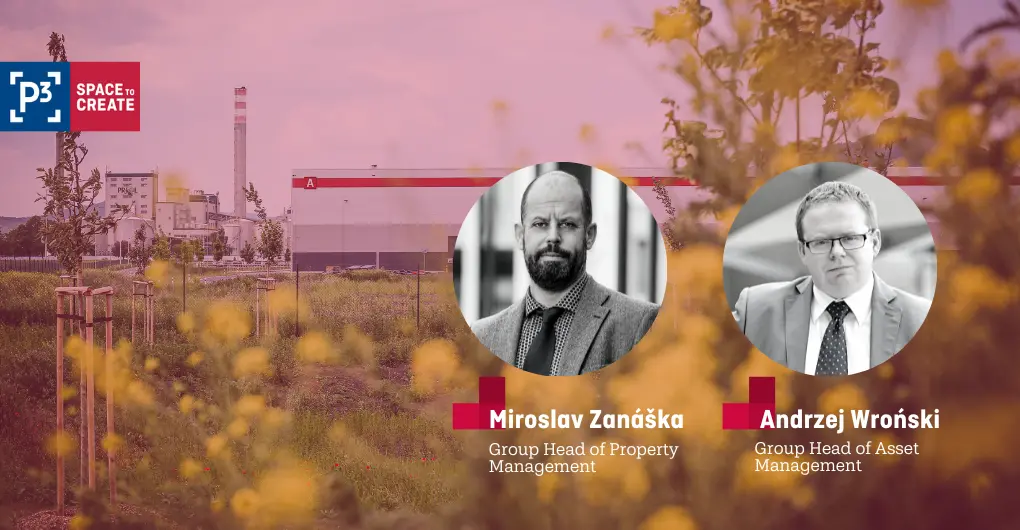

Logistics developers play a key role in ensuring modern supply chains continue to work for customers across Europe, despite the turbulence and change which have defined the decade so far. P3’s asset and property management experts discuss how the warehouse sector keeps up with demand and expectations during an era of challenges and technological acceleration.
This article features Miroslav Zanáška, Group Head of Property Management at P3, and Andrzej Wroński, P3’s Group Head of Asset Management. Both roles are separate but closely related: property management involves ensuring assets operate well and maintain their quality for customers, while asset management is about optimising the value of commercial properties as investments.
What’s influencing the warehouse sector in 2023, away from headlines about the conflict in Ukraine and post-pandemic disruption?
Andrzej: ‘The logistics environment is becoming more sophisticated and digitised each year, for example in productivity tools which allow you to be more effective at higher speed. This speed is one of the key requirements of our work today. Indeed, the pace of this change is a big influence. The environment is changing so much that we need to speed up in order to not lag behind and this pressure is upon both customers and logistics players to be as agile as possible, as the competition is also adapting.’
Miroslav: ‘In my role, the acceleration comes mostly from technological development; for example, data collection tools. Nowadays, we are able to get data in seconds from a warehouse on the other side of the continent. In other ways, the core of the business is the same as it always has been. Sometimes, it’s good to ask if speed is always the ultimate consideration: is it better to have automated data straight away, or to have a more complete data set in a week’s time?’
The world changes, but warehouses are still just four walls and a roof, aren’t they?
Andrzej: ‘Warehouses are definitely no longer only about logistics and space for shelving. Within our portfolio, we have customers from a variety of sectors such as 3PL, food & non-food retail, automotive, and light production. We even have a climbing park. So it’s about flexibility, which means finding the right solution that works for both a tenant to accommodate their needs and the asset owner to allow re-letting.’
Miroslav: ‘We're in 11 countries across Europe, with a portfolio of about 7.6 million square metres across 310 buildings, occupied by 475 clients. This means we get to see many different use-cases. To be successful, developers and owners must recognise each market is specific and distinct, and that you must respect the different needs of your customers. Ultimately, it’s about ensuring both the owner and occupier feel like winners.’
Is what customers want from warehouse owners / developers different in 2023?
Miroslav: ‘After the damage done to European supply chains by the pandemic and the ongoing disruption caused by war in Ukraine, clients really want stability and long-term partnerships. For example, many businesses are struggling with Just-in-Time logistics due to all the disruption and they want landlords which offer stability, in order to counteract negative influences. A successful property owner/developer is also able to offer extra space when it’s needed, or even develop entirely new Build-to-Suit warehouses. Responsiveness like this is what helps stabilise supply chains, especially in a logistics market that is characterized by land scarcity and at the same time strong growth and high demand.’
Andrzej: ‘Occupiers want the best possible space for an attractive rental price. At present, rental growth and rising costs for everyone are pain points, while the macro-environment is changing from a tenant’s market to a landlord’s market. What’s behind the rising costs? Inflation is high, construction materials and energy have become more expensive and financing hurdles for investors have increased. For navigating economic times like these, partnerships with customers are absolutely key.’
Miroslav: ‘Operationally, the main thing is being in close contact with customers, however that happens. Communication is the number one priority, otherwise the business doesn’t work. The tenant operates the asset, so their needs should be reflected. The information that a landlord gets depends on the tenant, so there should be regular meetings as well as portals for daily tickets and shared information platforms. Basically, it’s important to always be ready to support customers.’
New regulation such as the European Supply Chain Act embeds Environmental, Social and Governance (ESG) more deeply into European logistics. What’s the impact upon business of ESG?
Andrzej: ‘Obviously, sustainability is the right way forward and asset owners also need to make ESG work in an economic sense. Asset and property management today involve being agile and understanding the capabilities and possibilities of technology to help save energy. Generally, this means delivering modern, sustainable buildings and keeping existing buildings in good condition and up to date for tenants, to ensure they’re at a high level of quality for energy saving management. We’re investing in LED lighting which is an easy win, and also working closely on solar power by setting our strategy and targets for new assets and existing ones. Over the past years, we’ve worked on certifying our existing properties at least at a BREEAM ‘Very Good’ level or equivalent and the new buildings at least at an BREEAM ‘Excellent’ level or equivalent. At the end of 2022, we were able to exceed our target of 75% certification rate of our portfolio with ‘Very Good’ or higher.’
Miroslav: ‘It’s about flexibility. ESG is heavily regulated in many countries and sometimes these rules vary market by market and the regulations may not be clear. Even if sustainability has always played an important role in the way we develop and run our buildings, the current regulation environment is new terrain for us and for clients; the only way to thrive is to be flexible. ESG brings many new requirements and limitations, so you need to be very adaptable, often while not having much time to absorb the changes.’